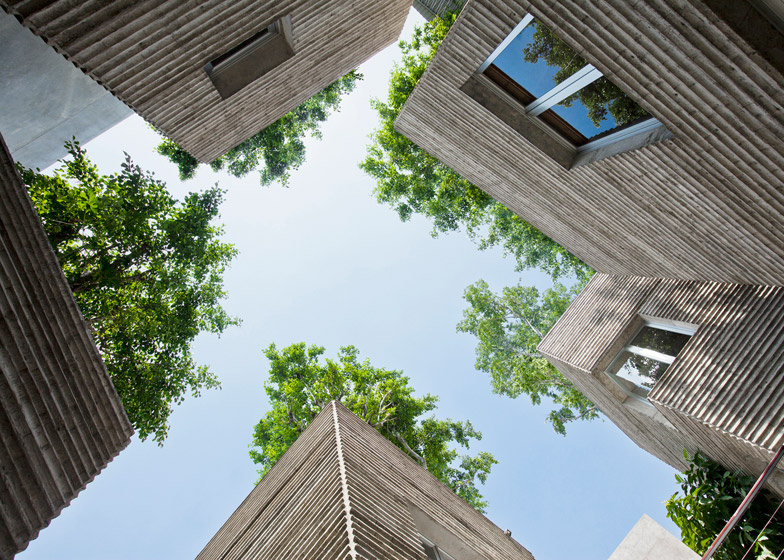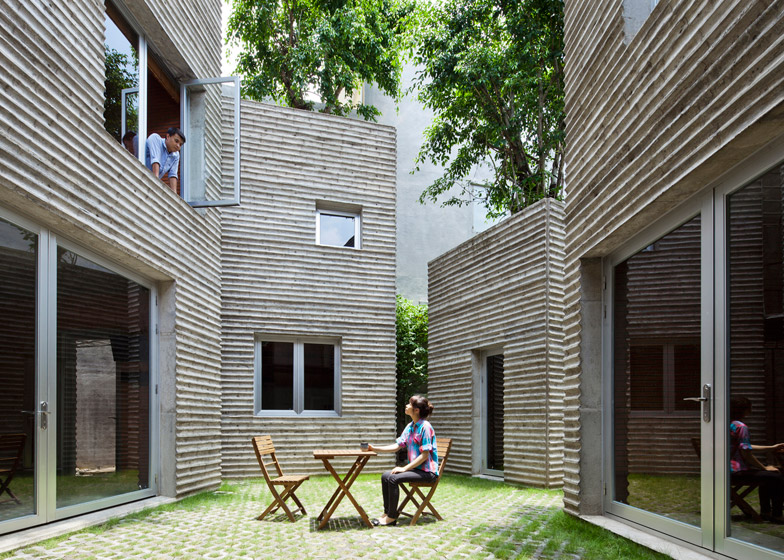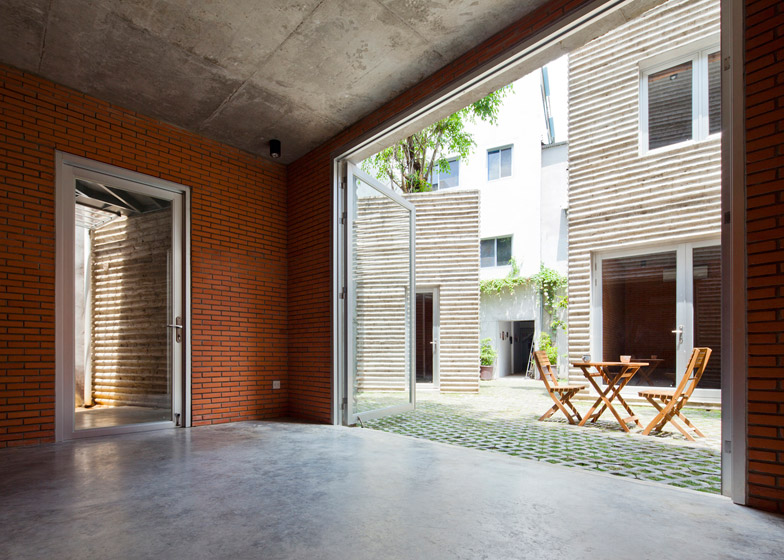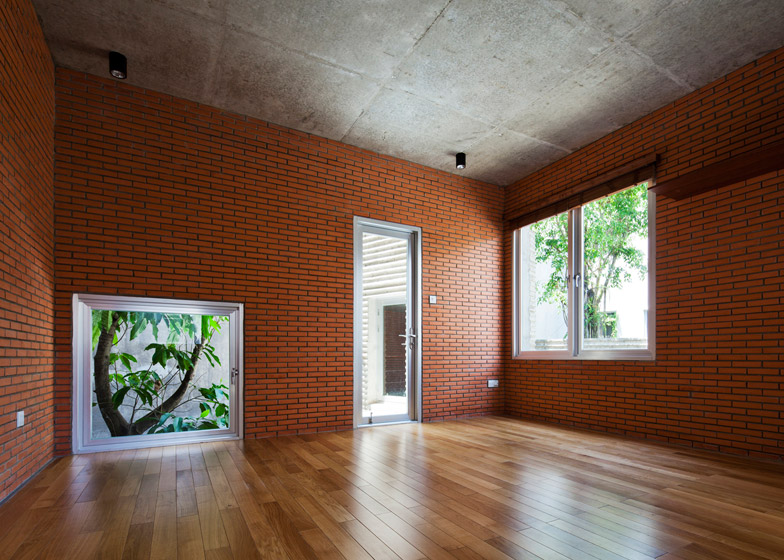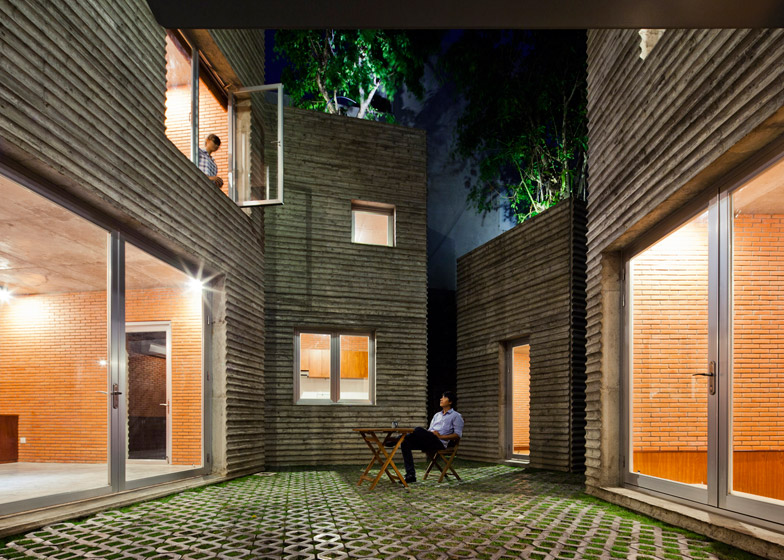Trees grow on top of five concrete boxes, like oversized pot plants, at this house in Ho Chi Minh City by Vietnamese studio Vo Trong Nghia Architects (+ slideshow).
House for Trees by Vo Trong Nghia Architects is a two-bedroom home for a family of three. It is built on vacant land hemmed in by buildings on all sides, in one of the most densely populated areas of Ho Chi Minh City, which has just 0.25 percent of its area covered in greenery, according to the architects.
"The aim of this project is to bring green space back into the city, accommodating high-density dwelling with big tropical trees. Five concrete boxes are designed as 'pots' to plant trees on their tops," said the architects, whose previous projects include a spiral-shaped house covered in grass, and a cafe with huge bamboo columns.
Banyan trees were chosen for the roofs because they have above-ground roots. "This tree has aerial roots, and fewer underground roots, so we think it is suitable to plant on top of the boxes," the architects told Dezeen.
The roofs are also designed to retain storm water in order to prevent flooding, with soil more than 1.5 metres deep, which required significant structural support beneath.
"In order to support the weight of the soil, water and trees, we built a load-bearing wall structure, which is not very common for Vietnamese houses," said the architects.
The buildings are arranged around a central courtyard, with few windows at the back to maintain privacy, and large glass doors and windows at the front to maximise daylight and ventilation.
"The courtyard and gardens, shaded by trees above, become part of the ground floor living space," said the architects. "Blurring the border between inside and outside, the house offers a tropical lifestyle that co-exists with nature."
The smallest box by the entrance is single-storey and houses an altar room. The other four boxes are all two-storey, with communal areas on the ground floor, and more private spaces on the top floor.
The first of the two-storey boxes contains a library and bedroom above. The next box houses a kitchen, and storage on the floor above. The box next to this has the dining room and a bedroom above. The final box, set furthest into the plan, has bathrooms on both levels.
Metal bridges connect the upper levels of the different buildings and create shaded corridors beneath them to connect the ground floors.
The exterior walls are made of in-situ concrete with bamboo formwork, while the locally sourced bricks have been left exposed inside. A ventilated cavity between the internal brick and exterior concrete walls prevents heat transfer, to maintain comfortable indoor temperatures.
Local and natural materials were chosen to reduce the home's carbon footprint and keep costs down.
"Considering the unique structure, it was a tight budget, so we minimised the finishing materials," said the architects. "The ceilings are exposed concrete and the interior walls are exposed brick, which is one of the cheapest materials in Vietnam."
House for Trees recently won first prize in the AR House 2014 awards. Previous winners include a self-sufficient Chinese house with terraces for growing food and a sustainable house covered in rubber.
Photography is by Hiroyuki Oki.
Here is some more text from the studio:
House for Trees, Ho Chi Minh City, Vietnam
Under rapid urbanisation, cities in Vietnam have diverged far from their origins as sprawling tropical forests. In Ho Chi Minh City, for example, only 0.25% area of the entire city is covered with greenery. An over-abundance of motorbikes causes daily traffic congestion as well as serious air pollution. As a result, new generations in urban areas are losing their connection with nature.
House for Trees, a prototypical house within a tight budget of 156,000 USD, is an effort to change this situation. The aim of the project is to bring green space back into the city, accommodating high-density dwelling with big tropical trees. Five concrete boxes are designed as "pots" to plant trees on their tops. With thick soil layer, these pots also function as storm-water basins for detention and retention, therefore contribute to reduce the risk of flooding in the city when the idea is multiplied to a large number of houses in the future.
The house is located in Tan Binh district, one of the most densely populated residential areas in Ho Chi Minh City, where many small houses are crowded together. The site is a remnant landlocked block within this suburb, accessed only by a small pedestrian lane. Resonating with this urban tissue, the house is designed as an accumulation of small fragments. Surrounded by typical Vietnamese row houses on all sides, House for Trees stands out like an oasis.
Fitting into the informal shape of the site, five boxes are positioned to create a central courtyard and small gardens in between. The boxes open to this central courtyard with large glass doors and operable windows to enhance natural lighting and ventilation, while remain relatively closed on the other sides for privacy and security. Common spaces such as the dining room and library are located on the ground floor. Upper floors accommodate private bedrooms and bathrooms, which are connected through bridge-cum-eaves made of steel. The courtyard and gardens, shaded by trees above, become part of the ground floor living space. Blurring the border between inside and outside, the house offers a tropical lifestyle that coexists with nature.
Local and natural materials are utilised to reduce cost and carbon footprint. The external walls are made of in-situ concrete with bamboo formwork, while locally-sourced bricks are exposed on the internal walls as finishing. A ventilated cavity separates the concrete and brick walls to protect interior space from heat transfer.
Architect: Vo Trong Nghia Architects
Principal architects: Vo Trong Nghia, Masaaki Iwamoto, Kosuke Nishijima
Project architect: Nguyen Tat Dat
Location: Tan Binh, Ho Chi Minh City
Floor area: 226.5m2
Footprint: 111.7m2
Site area: 474.3m2
Maximum Height: 10.3m
Construction cost: US$156,000


